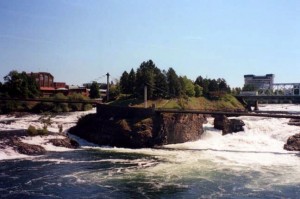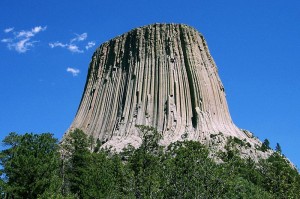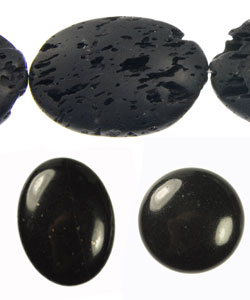- NEW DVD Series – Stone Setting with Bezels
- Tube Set Charm by Kim St. Jean
- Prong Basket Pendant by Kim St. Jean
- NEW DVD Series – Stone Setting with Cold Connections
- New DVD Series – Stone Setting with Wire
- NEW DVD Series: Introduction to Stone Setting by Kim St. Jean
- Featured Tool: Bracelet Bending Plier
- NEW Dvd by Eva Sherman
- Fun, Fast Fold Forming DVD Series
- Double Band Ear Cuff from Alex Simkin
Gem Profile Feb 22: Basalt
by Layna Palmer, Wire-Sculpture.com

Basalt
Shop Lava Beads| Shop Basalt Cabochons
As I said last week, I love the processes of our amazing Earth. This week we’re going to talk about a pretty amazing, but really basic rock: Basalt.
If you look at basalt, you won’t find much. It’s black with no real crystalline structures and hardly any sparkle, dazzle or sheen (unless polished of course). Yet, for all of its boring attributes, the story of basalt is one of fire, floods and excitement…okay, if you like volcanoes like I do, then it’s exciting!
How Basalt is Formed
Basalt is the most common rock in the Earth’s crust, and the sea floor is mostly made of basalt. It is classified as igneous extruded volcanic rock with aphanitic to porphyritic texture composed mostly of plagioclase and pyroxene minerals and has very little silica giving it a low viscosity.
So, in plain English: Basalt is very liquid lava, rich in magnesium and iron with a low silica content that cools with barely any discernible crystal structure within the rock. Basalt originates at the Mid-Atlantic Ridge, hotspots, shield volcanoes and other volcanic regions. We’ve even found basalt on the moon and on Mars.
Because basalt is the most common rock on our planet, let’s take a little time to explore where it’s found. One of the ways that basalt forms is through divergent plate boundaries like the Mid-Atlantic Ridge which splits the North-American and Eurasian plates. Iceland, the Azores and the Canary Islands are along this ridge. Newer rock is closest to the plate boundary and the spreading causes ridges to form as the lava cools and spreads. An interesting factoid; our Earth changes polarity every now and then which we have been able to measure by studying the sea floor spreading along ridges. Magnetite is a common component in basalt and will line itself up with magnetic north allowing us to measure the frequency of polar reversals.
Basalt also forms as a result of hotspots, or magma plumes, just below the ocean crust which then forms shield volcanoes like the Hawaiian Islands and the Galapagos Islands. Basalt also forms the largest volcano in our solar system, Olympus Mons on Mars, and it makes up the floor of the lunar seas on the moon.

Glowing molten basalt, image via
It might be under your feet!
Magma plumes are also responsible for the many basalt flood plains on the continents throughout the earth as well. On the continents we also have a hotspot underneath Yellowstone National Park that has erupted with large basalt flows in the past. We can even trace tectonic plate movement by looking at the Snake River plain in Southern Idaho; you can trace the path the land took across the Yellowstone hotspot by the “smile” in Idaho. This same magma plume was also responsible for the large basalt flood plains throughout the region including the Columbia River Basalt Plains in Washington and Oregon. These were caused by huge fissures opening up on the surface of the Earth and allowing the hot lava to flow.
Because basalt has low silica content, the lava can flow up to 15 mph and cover a large area. The basalt flow on the Columbia River plain is nearly 6,000 feet deep in places and covers over 100,000 square miles.

Spokane, Washington, like much of the Northwest, resides on a field of basalt. Spokane’s famous river runs through the city – those rocks in the water are basalt. image via
This, however, is dwarfed by the Siberian Traps which are estimated to have erupted enough lava to cover nearly 37 million square miles of land and is being put forward as the main cause of the demise of the dinosaurs. These types of flood plains are found all over the world, though in smaller quantities.
Basalt also forms in dikes, sills, and columns that have proven to be quite a puzzle to early geologists. In Ireland lies a formation called the “Giant’s Causeway” that is made of basalt columns that have cooled and begun to shrink, forming long columns of rock that look like different geometric shapes from the top.
In the United States, the Devil’s Tower in Wyoming is a great example of this same columnar jointing; this was formed when a basalt volcano cooled and fractured into columns. Over the years, the outside of the volcano was eroded away, leaving the hard basalt underneath. The Devil’s Postpile near Mammoth Lakes, California is another example of columnar jointing as is Paul Bunyan’s Woodpile in central Utah.

Devil’s Tower in Wyoming. image via
Depending on where you live, it may be called buh-SALT or BAA-salt, but either way, it’s hardened lava. It can look like charcoal pellets, but it can also be a nest for amethyst or other gems to grow inside.
Well, I’m getting pretty long-winded about a boring black rock, but I did tell you that even though the rock is rather plain and not very exciting, the process for us to be able to see and use it is fascinating! Basalt does have a hardness of 8 on Moh’s Scale making it a very hard rock, but it will take a nice polish, though it’s just as beautiful in the unpolished state.
Non-Jewelry Basalt Uses
Basalt stones are used in massage therapy to help alleviate stress. They’re also thought to rid the body of anger and help with understanding another’s point of view; even to promote reproductive health and bring stability and clarity. If you’re going through a difficult time in your life, Basalt is said to be able to help you draw your upon your own “fire within” and diminish the negative influences in your life.
Next, we’re going to take a look at lepidolite and sugilite. Have you ever used a piece of sugilite or lepidolite in your jewelry – or do you have pictures of sugilite or lepidolite specimens? Send us a picture at tips@wire-sculpture.com and we’ll feature it in next week’s gem profile. See you then!
Resources & Recommended Reading
- Basalt Healing Properties
- Columbia River Flood Basalt Province
- Basalt on Galleries
- Basalt on USGS
- What Is Basalt, How Does It Form and How Is It Used?
Gem Profile by Layna Palmer
Click to Receive Daily Tips by Email





















0 comments